When standing, the support reaction force is equal to body weight; when walking, this force is compounded by the force of inertia and the force generated by the muscles pushing off the support.

- How do you find the right shoe size?
- How do you measure your feet?
- DIFFERENCE BETWEEN FORMOTIX AND OTHER STEEL INSERTS
- STEPS OF FOOT CORRECTION WITH THE FORMOTIX SYSTEM
- Orthopedic shoes for different leg lengths
- Causes, stages of development and treatment of flat feet in children.
- Limb shortening: prevention and treatment
- Limb shortening: an innovation
- How much should you spend on children's shoes?
- Is it worth buying outgrowth shoes for children?
- How to choose shoes for teenagers so that there are no miscalculations?
- Why does the menstrual cycle change?
- self-employment and job search
- questions and answers
- Drugs used to treat cerebral circulatory disorders
- Neuromaxol in the prevention and treatment of cerebral circulatory disorders
How do you find the right shoe size?
Nowadays, more and more shoes are ordered from online shops. So you have a large selection and saves a lot of time. Before you buy a pair of shoes from afar, you might have a number of questions. How to choose the right shoe size? What parameters should you pay attention to when choosing a particular model or type of shoe?
Finding the right shoe size is not only crucial for comfort and fit, but also for good posture and well-being. After all, we wear shoes all the time these days: at work, on vacation and often at home too. This is how we spend ⅔ of our day, and our feet only rest when we sleep... So, before buying shoes, there are a few simple rules to keep in mind:
- Shoes should fit snugly without squeezing or pinching the foot.
- Shoes that are too tight lead to blisters and abrasions.
- Shoes that are too large are detrimental to foot health: the toes slide inward to keep the foot from sliding toward the toes or heel, causing excessive stress on the foot.
Below you will find detailed information on choosing the right shoe size, which can serve as a guide when ordering shoes from an online shop.
How do you measure your feet?
- The shoe size is made up of several measurements: foot length, forefoot and instep.
- An easy way to determine the correct foot size is to take a piece of paper and a pencil. Standing, with both feet shoulder-width apart, make a cut down the length of the feet from heel to extreme toe, holding the pencil perpendicular to the sheet. This is done to ensure maximum stress on the foot.
- The foot tends to contract and expand as you walk, so measuring with your back full gives the maximum length. Another way to measure is to sit on a chair and bend your knees to a right angle. However, there may be a slight error here because the foot is not fully loaded, resulting in a slight shortening of the size.
- When buying autumn and winter shoes or sneakers, you can wear a sock.
- It is best to measure in the evening, when the feet are slightly swollen and swollen to the maximum. This is a natural process that is also typical of healthy feet that have had time to 'fat' during the day.
Use a tape measure or ruler to measure the distance between the two strikes. For example, if the length of your foot is For example, if your shoe size is 24.5 cm, your shoe size is 39. If the length of your foot is 24.8 cm, your shoe size is 39.5. It is ideal to measure the left and right foot as they are often different. As a rule, the right foot is slightly longer than the left, but there are exceptions. If one foot is longer than the other, choose larger values.
- There are no in-between sizes in the Tamaris collection, so we recommend choosing one size up so that you can feel comfortable even when your feet are swollen in the evening.
- When it comes to indoor shoes for the summer, it is better to order shoes at least 1 cm longer than usual. The same applies to all sports shoes - sneakers and athletic shoes - for greater comfort and better foot dynamics during exercise and sports activities.
- The opposite is true for open sandals and heeled sandals; ideally they should fit snugly so that the toes and heel do not protrude beyond the sole.
- Winter shoes should always be ordered one size larger, as the extra space in the shoe gives your feet extra warmth.
DIFFERENCE BETWEEN FORMOTIX AND OTHER STEEL INSERTS
These insoles are made by Foot Science International (New Zealand) from a 'smart' material called thick polyolefin. When heated to a certain temperature, these insoles become malleable and can be quickly fitted to the foot. When walking, the foot forms itself within a few minutes: the structure of the material remembers all changes in the shape of the foot during movement. The shaping in motion is the unique difference between Formtotics and other custom insoles.
The second special feature is the individual correction, which takes place about 1 month after the insoles are made. Again, your feet will be included in the correction process. The doctor places corrective wedges on the insoles, which are based on the 'wishes' of your feet. After the correction, you will immediately feel how easy it is to keep your balance when standing on one foot, even with your eyes closed. Gradually, the pain in your feet will disappear and you will feel more comfortable standing and walking.
It should be noted that the diagnosis and treatment with the FormTotix system is carried out exclusively by physicians. Thanks to his expertise, the doctor is able to diagnose foot abnormalities and select the optimal orthosis model for your feet. Where unique technology and the golden hands of doctors combine, a true miracle happens!
STEPS OF FOOT CORRECTION WITH THE FORMOTIX SYSTEM
- diagnosis. A face-to-face consultation between doctor and patient to identify problems related to existing musculoskeletal disorders. A function test is used to diagnose posture and gait. Visual diagnosis of the feet is performed using a Green Food Podoscope. The main cause of diseases of the musculoskeletal system (heel spurs, corns, bones, joint and back pain, foot swelling) is determined.
- Choice of 'inserts. Once the cause of the musculoskeletal complaints has been determined, an insole model is selected. The selection of the insole model depends on the degree of foot deformity, the size of the foot, body weight, the patient's age, the footwear used and the intensity of physical activity of the foot.
- Shaping and fitting of insoles to the foot. If indicated, corrective pads will be placed on the inside of the pads. The insoles are then inserted into the sneakers and heated to a plastic state with a special hair dryer. The ability of the insoles to change their plastic state makes it possible to customize the insole to the foot. Within 3-4 weeks after using the insoles in the shoes, a dynamic adjustment of the insoles to the foot takes place.
- Customization of the insoles. The first correction of the insoles takes place one month after the production, a second correction 3 and 6 months after the production. When correcting the insoles, gait and posture as well as the deformity of the insoles are assessed. The correction of the insoles is carried out with functional wedges in order to fully adapt the insoles to the foot.
Practical for everyone, but especially for children, pregnant women and people who are active in sports. Statistically, 75% of children aged 5-6 years have flat feet and by the age of 25-30 years 95% of humans have severe musculoskeletal deformities.
Orthopedic shoes for different leg lengths
Everyone knows what a heel spur is! It is a thorn that has grown by itself and unhappily presses into the sole when walking.
Usually nothing grows by itself (apart from tumors). But a spur is not a tumor! But perhaps it is so innate that at the age of 40 or 50 he already says: 'My time has come!'.
The spur grows at the site of the damaged plantar fascia where it attaches to the heel. At some point, the fascia lacks its innate elasticity and through increased or sudden strain, increased weight, age-related changes in tissue elasticity - the fascia can no longer stretch and is damaged either in length or at its narrowest point - the heel. As the fascia is pulled away from the heel, it presses on the periosteum, which is quite painful due to its good innervation, and then forms bone tissue where the fascia is stretched.
Therefore, the heel spur you see on an X-ray is usually a consequence of the problem and isn't pressing on anything - it's an extension of the fascia.
✅ Relieving local plantar fascia areas and correcting foot alignment to reduce stress on fascia and chronically contracted foot muscles - custom made insoles
✅ Reduction of the flexion angle of the ankle during daily movement (the heel should be slightly higher than the toes in the shoe)
✅ Calf-ankle and plantar fascia stretching exercises throughout the day - assisting the fascia in stretching
✅ Shock wave therapy - a method for locally improving blood circulation and thus restoring the fascial tissue
✅ anti-inflammatory painkillers for prolonged or severe pain.
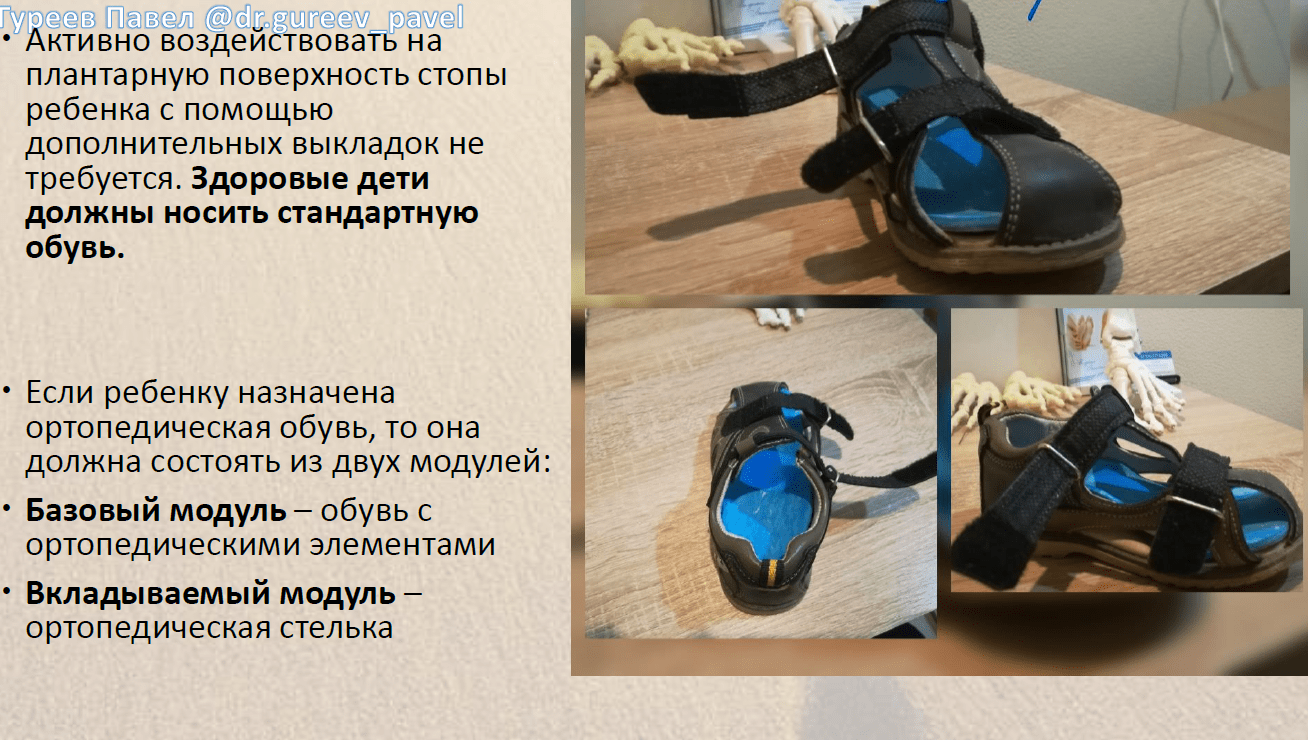
In a 2017 article in the Bulletin of the All-Russian Guild of Prosthodontists and Orthopedists, the staff of the renowned GA Research Center. Golubitsky, the German Society for Orthopedics, published an article. Albrecht came to the conclusion that orthopedic footwear should consist of two modules: the shoe itself and a custom-made orthopedic insole. A real orthopedic shoe should therefore have an orthopedic custom insole.
Causes, stages of development and treatment of flat feet in children.
We live in a world of smooth surfaces: tiles, asphalt, linoleum, laminate, even the playground floor is rubber, but smooth! Observations by podiatrists show that flat feet are common in children. This disease is quite insidious, is asymptomatic in childhood and can cause serious disorders with age. Most parents don't pay much attention to this condition, mistakenly believing that flat feet go away on their own with age. However, if treatment is not started on time, flat feet will only progress and deform the foot, so later treatment can be very difficult or ineffective. It is important for parents to consult a specialist at an early stage.
Both the development of all organs and systems of the child and the formation of the foot are of great importance for a fulfilling life in the future. Up to the age of 2, flat feet are physiological – the longitudinal arch of the foot is always flat. At the age of 3, the bones become denser, the ligaments stronger and the joints take on their correct position: the 'right foot' begins to take shape. This process continues until the age of 5, so that one can only speak of real flat feet from this age. The younger the child (especially up to the age of 3-4 years), the more the footprint resembles a flat foot. Therefore, a visit to an orthopedist is necessary to diagnose flat feet in children and recognize their symptoms. You shouldn't wait until your child is 5 years old to diagnose flat feet.
Dear readers, take good care of the health of your feet and the feet of your children. If you do not have the time to take preventive measures and set in motion a mechanism for further progression of the disease, you should urgently take treatment measures to improve your child's quality of life. Remember that pain in the foot, transverse or longitudinal flatfoot is not a punishment. By preventing and treating the condition, you help eliminate foot pain, improve your child's well-being and quality of life.
Limb shortening: prevention and treatment
The symmetrical, harmonious structure of the human body fulfills important biomechanical requirements. Under these conditions, the numerous segments of the human spine, pelvis and joints are structured in such a way that each segment provides strong physiological support to the parent segment.
The relative shortening of the lower limbs leads to overstretching of the muscles, fascia and ligaments of the joints of the limbs, spine, shoulders, neck and skull. Spinal curvature leads to impaired innervation of anatomical structures and to hyper- or hypo-activity of the parasympathetic or sympathetic nervous subsystems.
Parasympathetic hyperactivity occurs when the right pelvic bone is misaligned. This can be checked by standing with the right pelvic bone higher than the left, which means a relative shortening of the right lower extremity. Abnormalities lead to diseases of the stomach, liver, genitourinary system, diarrhea, a tendency to hypotension and emaciation. Overactivity of the sympathetic nervous system causes displacement of the left pelvic bone, leading to heart and lung disease, high blood pressure, and constipation.
If symptoms occur, especially in children, an orthopedist should be consulted urgently. This happens because. one leg is shorter than the other it causes a misalignment of the pelvis. Also different leg lengths, shortening of the leg during the growth phase of the child can lead to malformations of the skeletal system.. Urgent measures should therefore be taken to symmetry the limbs, the pelvic ring and the entire body.
Limb shortening: an innovation
Inventa Ortho Rehabilitation Center uses Inventa corrective insoles – biomechanical foot correctors. They align the foot conservatively and gently and redistribute the load on the limbs. compensation different foot lengths Restructures the movement pattern, improves metabolism and muscle tone, which accelerates the restoration of symmetry. Wearing a leg spreader Compensation for leg shortening. By replicating the unique topography of the foot, insoles greatly prolong the effects of any therapy by consolidating new muscle memory.
A testimonial of a patient who underwent rehabilitation and who was diagnosed with a shortened leg after rehabilitation can be heard here.
Compensator® insoles. relieves inflammation, stress on intervertebral discs, improves blood circulation, tissue nutrition and immunity.
In addition, the following is also displayed Massage of the shortened lower limbs. If one leg is shorter than the other . If one leg is shorter than the other, leg length balancing exercises are required.
Inventa Ortho Rehabilitation Center – orthopedic insoles, diagnosis and correction of the support system
How much should you spend on children's shoes?
Before you buy shoes, you should first measure your feet. It is advisable to add 1 cm to the measurements. This allows you to choose models that will suit your child for at least one season. Therefore, experts strongly advise against buying shoes, boots and other items that are too tight. In summer the foot tends to swell in the heat, while in winter the extra space has a warming effect.
But it is also not recommended to choose models with an overhang of more than 1 cm. Such products contribute to the deformation of the foot, the child will find it harder to move, and the gait may become irregular.

Therefore, those who are interested in determining the size of children's sneakers should follow the following rules:
- If the supinator is not under the arch of the foot, an acceptable margin of more than 1-1.2 cm means that the shoe is too big;
- If your child's toes stick out over the edge of the shoe (in the case of sandals), the leather rubs, or the toes get caught in the shoe, you may find that the pair you bought is too small;
- A correctly sized shoe has an inch of forgiveness and the position of the spine is above the arch of the foot.
In order not to make a wrong choice, the foot should be measured with a foot diagram. To do this, the child's foot is placed on a piece of paper, outlined with a pencil and cut out. The footprint is then inserted into the model to be purchased. When buying online, the principle is the same, but the measurements are taken based on the length of the insole.
Is it worth buying outgrowth shoes for children?
When buying shoes to grow out of, you need to buy a deliberately large pair. This decision – is not the best solution. There are several reasons for this:
- Inconvenience. Wearing big shoes, sneakers - is uncomfortable and for an adult, let alone a child. This decision carries the risk of gait errors and deformation of the musculoskeletal system.
- Increased risk of injury. Overpriced children's models increase the risk of injury. In other words, the child may trip and fall. This is especially true for babies who are just learning to stand.
- blistering. Not only small sizes can cause blisters, shoes that are too big can also cause this phenomenon.
- Misaligned shoe inserts. In shoes or moccasins that are too big, the insole is not where it should be. As a result, their main function of preventing flat feet is lost.
If you take these points into account, you can choose the optimal size so that your child does not experience any discomfort.
How to choose shoes for teenagers so that there are no miscalculations?
When choosing shoes, the concept of 'outgrowth' is often confused with that of 'reserve'. The former means buying the wrong size, the latter means guaranteeing your child some comfort.
So the summer models should have a margin of about 7-8 mm. Sports or mid-season models are purchased with an additional margin of 1 cm. For winter boots, this number is maximum, up to 1.5 cm.
When choosing the 'sleeve', however, it should be remembered that it also influences the fullness. An increase of 1 cm in length also increases the width of the shoe. This causes the shoe to 'wobble' on the foot. This solution is not suitable, you need to look for models that fit all parameters.
Why does the menstrual cycle change?
The days of menstruation are not called periods for nothing: this indicates that they occur cyclically once a month. But a woman's body is not a clock: it is subject to external influences (stress, high physical activity, emotional disorders) that lead to shifts. A shift of less than 7 days is not considered abnormal - every woman's menstrual period shifts slightly from time to time.
However, if your cycle is very variable (e.g. 20 days and then 35), very short (less than 15 days) or long (more than 35 days), you should see your gynecologist. Remember to bring a journal with you to your appointment.
In order to normalize your cycle, your doctor may prescribe you special medication. This worries women because they think the only way to normalize their cycle is to take hormones. And these have many side effects: weight gain, mood swings, skin deterioration and other problems. But don't worry: hormones aren't always the only treatment. Vitex extract, iodine and B vitamins, which are important for ovarian function (these vitamins are usually absent in women who have been on birth control pills), can help normalize the menstrual cycle.
These ingredients, as well as minerals important for the female reproductive system, are contained in the Pregnoton complex, which effectively normalizes the menstrual cycle. You can start taking the drug on any convenient day. Course – 1 to 3 months (1 pack = 1 month).
IS NOT ADVERTISING. THE MATERIAL WAS CREATED WITH THE SUPPORT OF EXPERTS.
self-employment and job search
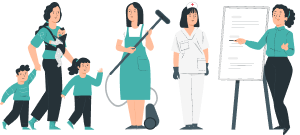
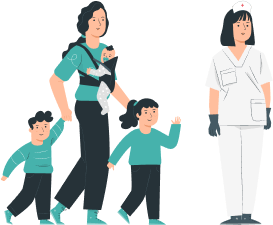
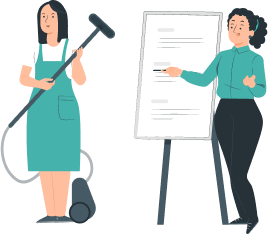
A Facebook group referred me to your website! I didn't really believe it was possible to find someone like that but I found a nanny within a week! There is a wide range of nannies vetted by professionals.
I found a nanny job on the website and messaged the employer who invited me for an interview. I recommend it to everyone!!!
Personally, I am very satisfied with the way the website works. Everything is legal, safe and reliable. I found a great nanny who is already working for us. I always recommend this website to my friends!
questions and answers
We recommend that you post a job posting so workers can submit their resumes. You can also select candidates yourself in the search area.
In the Search section, set the filters to a minimum distance and click Apply, then the system will show you all the employees who live nearby.
If the 'Submit Feedback' button is displayed, this means that the employee has not yet received any feedback, but the applicant may have personal references.
Drugs used to treat cerebral circulatory disorders
Various drugs are used to recover from brain injuries, to fight encephalopathies of various origins, to eliminate cognitive pathologies, to stabilize the blood supply to brain cells. The neuroprotective effect of nootropics and antioxidants in cerebral circulatory disorders is complex. The best known of these are:
- Cortexin – increases concentration and stress resistance, protects neurons from damage, increases neuron survival under hypoxia, and stimulates metabolism. Its tissue-specific action improves cortical function and the overall tension of nerve cells.
- Vinpocetine is a psychostimulant nootropic used to treat acute and chronic cerebral circulatory disorders. It acts as a vasodilator by lowering blood pressure, normalizing blood flow, increasing brain cell resistance to hypoxia, and stimulating glucose metabolism. In addition, it has antispasmodic effects.
- Neuromexol is an antioxidant, a membrane protector with a nootropic effect and has an anti-stress effect. It improves metabolism, normalizes dopamine production, lowers total cholesterol and fights the root causes of cerebrovascular problems.
Those affected should ensure that there is no lack of B vitamins, which have a positive effect on neuromuscular permeability.
Neuromaxol in the prevention and treatment of cerebral circulatory disorders
Among the drugs prescribed for cerebral circulatory disorders, there are more modern types of nootropics and antioxidants. This includes Neuromexol.
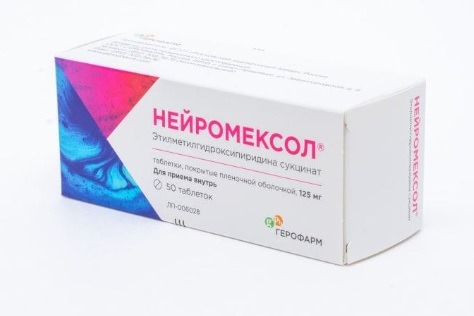
Neuromexol is a combination drug that has membrane protective and nootropic, antispasmodic and antianginal effects. The active substance:
- Normalizes the structure of blood cells, increases blood fluidity, so it flows better through blood vessels;
- Improves cerebral metabolism, reduces dystrophic changes in the brain;
- Stabilizes sleep and wake cycles, restores vegetative and cognitive functions;
- Lowers total cholesterol, which leads to the formation of atherosclerotic plaques in blood vessels.
Its use is indicated in autonomic dystonia, irritable bowel syndrome, encephalopathies of various types, anxiety and other neurological disorders, in combating the effects of trauma.
The information contained on this website is subject to consultation with your doctor and is not a substitute for direct consultation with your doctor.
Please refer to your User Agreement for further details.
- Orthopedic instep to correct different leg lengths.
- Baby foot size chart.
- Do orthopedic shoes help children?.
- Foot sizes for children.
- What putting your feet up means.
- Different leg length after a hip prosthesis.
- child's foot size.
- orthopedic shoes.
